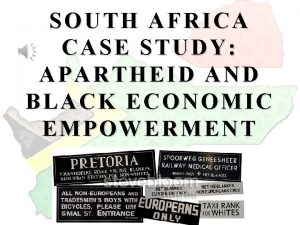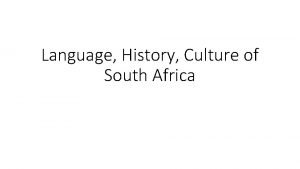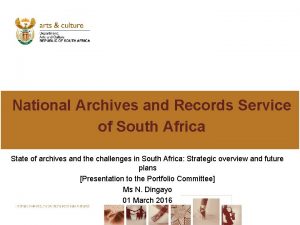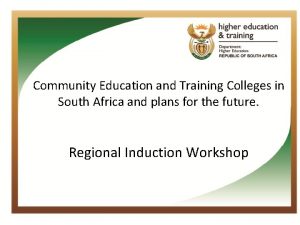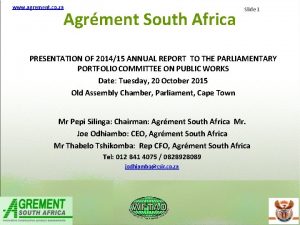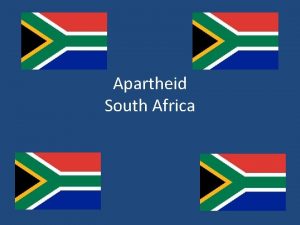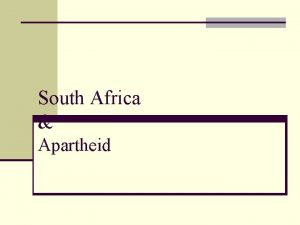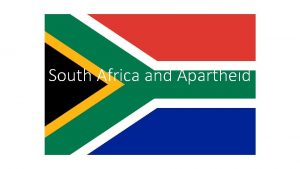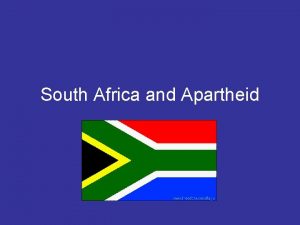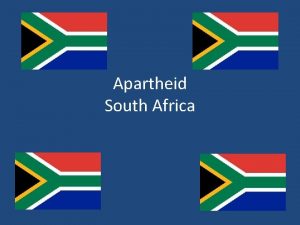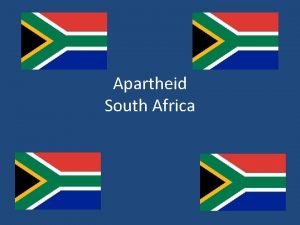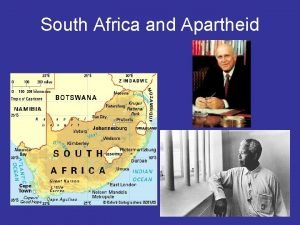South Africa and Apartheid What is Apartheid Look









- Slides: 9

South Africa and Apartheid

What is Apartheid? • Look to the right—what does this picture make you feel? • What does this picture tell you about Apartheid in South Africa?

Definition of Apartheid: • The term apartheid (from the Africkaans word for “apartness”) was coined in the 1930 s and used as a political slogan of the National Party of South Africa in the early 1940 s, but the policy itself extends back to the beginning of white settlers in South Africa. • The Afrikaner Nationalist implemented apartheid under law in 1948.

How was Apartheid enforced? The Population Registration Act of 1950, put all South Africans into 3 categories: 1. Bantu (black African) 2. White 3. Colored (of mixed races) A 4 th category: Asian (Indian and Pakistanis) was added later.

Policies to enforce Apartheid 1. Enforced by a series of laws passed. Group Areas Act of 1950 assigned races to different residential and business sections in urban areas. 2. The Land Acts of 1954 and 1955 restricted nonwhite residence to specific areas. Limited black land ownership. White minority controlled over 80% of South African land. 3. Prohibited social interaction between races; enforced segregation of public facilities, including educational. 4. Created race-specific jobs; limited power of nonwhite unions; and minimized nonwhite participation of government.

Response to Apartheid Around the World • Apartheid was denounced by the international community: In 1961 South Africa was forced to withdraw from the British Commonwealth by member countries who were critical of apartheid. • In 1985, governments of the U. S. and Great Britain imposed economic sanctions on South Africa in protest to its racial policy. • The main economic policy was an EMBARGO • Embargo – a stop or halt of trade due to political or economic reasons • The reason here being the international community did not like APARTHEID

Reform • President F. W. de Klerk began to dismantle the apartheid system in the early 1990 s. • The year 1990 brought a National Party government dedicated to reform and also saw the legalization of formerly banned black congresses (including the African National Congress) and the release of imprisoned black leaders. • In 1994, the country’s constitution was rewritten and free general elections were held for the first time in its history. • In 1994, Nelson Mandela’s election as South Africa’s first BLACK president brought an end to the apartheid system.

Important Men that ended Apartheid: • Throughout the years of Apartheid, two groups were working to end apartheid—the African National Congress led by Nelson Mandela and the Pan African Congress. • Riots and fighting took place constantly, and Nelson Mandela was sentenced to life in prison for his work against apartheid. • In 1990, South African President, (LAST WHITE) F. W. de Klerk agreed to allow the ANC to operate as a legal party and he released Nelson Mandela after 27 years in prison. • F. W. de Klerk also began to repeal (or get rid of) the apartheid laws.

The Numbers don’t Lie: • Population of South Africa: • 19 million blacks • 4. 5 million whites Annual expenditure on education per student: --$45 blacks/$696 whites Teacher/Student Ratio: --1/60 black: 1/22 whites Land Allocation: --13% black: 87% white
